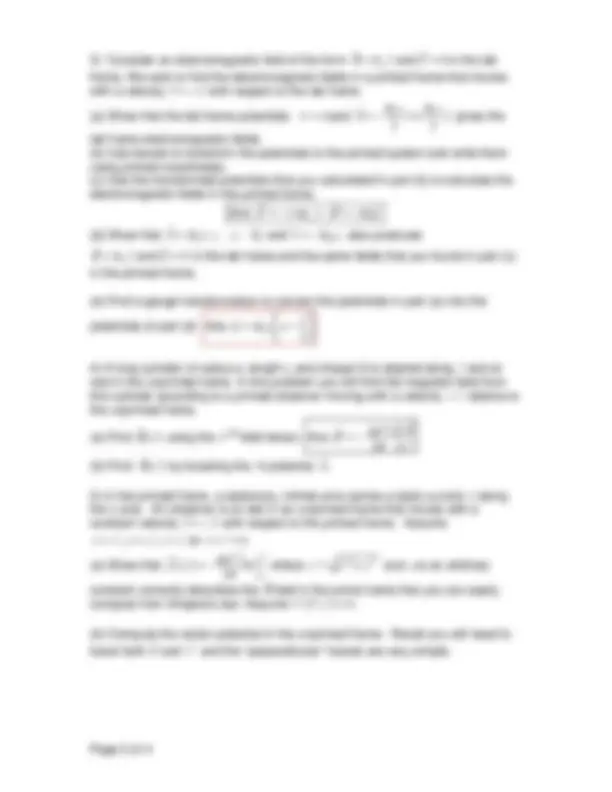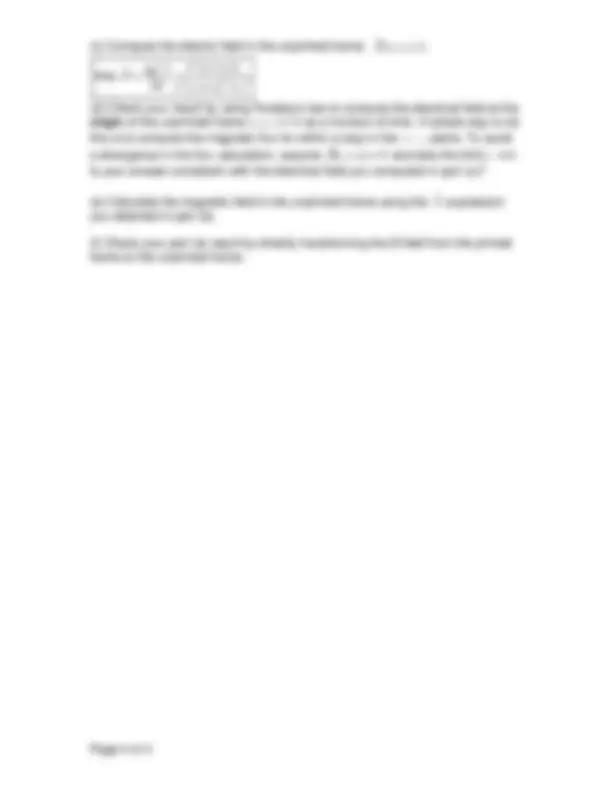




Study with the several resources on Docsity

Earn points by helping other students or get them with a premium plan


Prepare for your exams
Study with the several resources on Docsity

Earn points to download
Earn points by helping other students or get them with a premium plan
Community
Ask the community for help and clear up your study doubts
Discover the best universities in your country according to Docsity users
Free resources
Download our free guides on studying techniques, anxiety management strategies, and thesis advice from Docsity tutors
Material Type: Exam; Class: Electromagnetic Fields II; Subject: Physics; University: University of Illinois - Urbana-Champaign; Term: Unknown 1989;
Typology: Exams
1 / 4

This page cannot be seen from the preview
Don't miss anything!



a) I will post all homework solutions by Wednesday evening to help you prepare for the final. b) I will hold special office hours on Tuesday, December 9 from 2:30 – 4: pm to help with this homework.
Be sure to check that all of your grades are correctly recorded prior to the last day of class.
The final exam will be held in 158 Loomis on Tues, December 16 from 1:30pm– 4:30 pm
a) The final exam will be comprehensive covering all topics in the course. I will hold special office hours on Monday December 15, from 2:30 – 4: pm and on Reading Day, Thursday December 11 from 2:30 - 4:30 pm to answer questions about the final. b) I will work the (attached) final review problems on the Monday, December 8 and Wednesday, December 10 lecture. c) If you arrive on time for the exam on Tuesday you will have 3 hours to work the exam. i) There will be five problems on the final ii) Unlike the midterms you will need to turn in both your answers and the exam questions to receive credit. iii) The final exam is open book and open notes like the midterm.
Here is a description of the five problems:
(1) A problem computing the total force on a volume of charge and/or currents using the Maxwell stress tensor.
(2) A problem involving a time varying electric field where you calculate the Poynting vector, and integrate the Poynting vector over a surface in order to compute the electrical power delivered to the surface currents.
(3) A problem concerning a waveguide, the dispersion relation for the wave guide, and the pressure on the waveguide walls.
(4) A relativistic kinematics problem involving using the four-velocity to compute the time interval and distance separation of events in several different frames.
(5) A problem where you calculate electric and magnetic fields from a vector potential, transform the four-vector potential to a moving frame, compute the
fields in the moving frame, and check your results using F^ μν^.
which produces a magnetic field of B = B z 0 ˆ
using F = ∫ T da S
i and two different
bounding surfaces:
(a) Bound the y > 0 half of the solenoid with the y = 0 plane.
2 Ans: 0 y
(b) Now bound the y > 0 half-solenoid with two half-cylinders with radii of
x B xB ikz i t a
which is guided
between two, perfectly conducting parallel plates at x=0 and x=a.
(a) Find the dispersion relation which gives k as a function of ω.
(b) Compute the electrical field for this wave.
(c) Show that both the electrical and magnetic fields satisfy the conductor boundary conditions.
(d) Find the ratio of the average electric energy density to the average magnetic
energy density for a point on the plane 2
a
and physical constants as needed.
2 Ans: e 1 m
u c u a
(e) Compute the surface currents, and surface charge density on the x=0 plane.
Show that K 0 t
i.
(f) I think you will find that Ez = Bz = 0. But aren’t TEM waves forbidden in a
hollow wave guide? Explain how your solutions can be valid in light of this.
2.5) A square wave guide aligned along the z-axis with dimensions a by a carries
y K K ikz i t z a
on the x=0 conductor.
(a) Find the magnetic field on the x=0 plane
(b) Find the charge density on the x=0 plane using surface continuity
(c) Calculate the time averaged pressure on the x=0 plane at y = a / 2 using the
Maxwell stress tensor and indicate the direction of this pressure. Are there any
sheer forces on the x=0 plane.
2 2 0 2 2
K c a
2 0 P↑ = − 2
(d) Use x-y symmetry to find the B-field everywhere within the wave guide
(c) Compute the electric field in the unprimed frame: E x y z t ( , , , )
2
2 2 2 2
Ans:
I z v x^ vt E x vt y
(d) Check your result by using Faraday’s law to compute the electrical field at the origin of the unprimed frame ( , x y z , ) = 0 as a function of time. A simple way to do
this is to compute the magnetic flux for within a loop in the s − z plane. To avoid
a divergence in the flux calculation, assume B s ( < a )= 0
and take the limit a → 0.
Is your answer consistent with the electrical field you computed in part (c)?
(e) Calculate the magnetic field in the unprimed frame using the A
expression you obtained in part (b).
(f) Check your part (e) result by directly transforming the B-field from the primed frame to the unprimed frame.